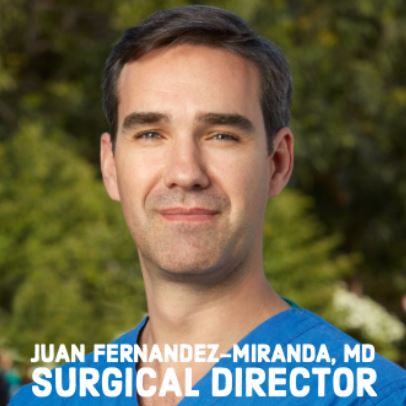 This month the PNA Spotlight focuses on Dr. Juan Carlos Fernandez-Miranda, a Professor of Neurosurgery and the Surgical Director of Brain Tumor, Skull Base and Pituitary Centers at Stanford University. Dr. Fernandez-Miranda did a neurosurgery residency at La Paz University Hospital in Madrid, Spain. He completed a fellowship in microsurgical neuroanatomy at the University of Florida. He did clinical training in cerebrovascular surgery at the University of Virginia, and in endoscopic endonasal and open skull base surgery at University of Pittsburgh Medical Center (UPMC). He joined the faculty at Stanford earlier this year. He was kind enough to answer some questions from the PNA. His answers are below:
This month the PNA Spotlight focuses on Dr. Juan Carlos Fernandez-Miranda, a Professor of Neurosurgery and the Surgical Director of Brain Tumor, Skull Base and Pituitary Centers at Stanford University. Dr. Fernandez-Miranda did a neurosurgery residency at La Paz University Hospital in Madrid, Spain. He completed a fellowship in microsurgical neuroanatomy at the University of Florida. He did clinical training in cerebrovascular surgery at the University of Virginia, and in endoscopic endonasal and open skull base surgery at University of Pittsburgh Medical Center (UPMC). He joined the faculty at Stanford earlier this year. He was kind enough to answer some questions from the PNA. His answers are below:
What inspired you to choose your career path?
When I was a young kid, about 10-11 years old, I got sick with a skin rash and high fever; the family doctor visited our home, carefully examined me, and based on a number of clues, he determined I got a very rare bacterial infection known as scarlet fever; a few days of antibiotic medication and I was back to normal. I now realized that I was fascinated by the wisdom, expertise, and detective attitude of the physician, and this personal event was (I now know) key to my future decision to become a doctor.
As I started medical school, I became deeply interested in the structure of the brain and how it explains brain and perhaps even mind function. I realized that the closest I could get to know the brain was actually as a surgeon operating on it.
I became a neurosurgery resident, and I immediately felt that entering into a patient’s brain, skull base, or pituitary gland was a huge privilege and a unique experience that will require my entire devotion and attention. I learned from my mentors the importance of precise knowledge of surgical neuroanatomy to perform gentle, accurate, and safe surgery. After residency training, I decided to spend 2 entire years in the lab – fully dedicated to mastering the understanding of the complex tridimensional surgical neuroanatomy required to safely and efficiently navigate the brain and skull base. These years, under the guidance of legendary neurosurgeon Albert Rhoton, served as the basis of everything I have accomplished thus far.
I was then fortunate to continue my clinical training at University of Virginia with several giants of neurosurgery, and I was greatly influenced by the meticulous approach of Dr. Ed Olfield’s pituitary surgeries, particularly for Cushing’s disease. It was such a joy to watch his precise extracapsular tumor resections. At the same time, I had become totally enchanted by the endoscopic endonasal operations that Dr. Amin Kassam was performing at University of Pittsburgh, and after many requests he finally accepted me for specialized training with him and his team. That was a life changing event for me, as my career was about to be centered in the development and refinement of endoscopic endonasal skull base and pituitary surgery.
What is the primary focus of your work/research?
My primary clinical focus is the treatment of patients with pituitary, skull base, and brain tumors. I have particular technical expertise in endoscopic endonasal surgery for pituitary tumors and other skull base lesions, such as craniopharyngiomas, meningiomas, and chordomas, with an accumulated surgical experience of more than 1,000 cases. My clinical practice includes a full range of minimally invasive approaches, in addition to complex open skull base and brain surgery.
My research interests lie in the study of surgical neuroanatomy and the application of innovative techniques into the operating room that aim to improve surgical safety and effectiveness. As an example, along with my fellows, we have recently provided a new compartmental classification of the cavernous sinus that may help improve resection rates of pituitary tumors that invade the cavernous sinus, while preserving cranial nerve function. We have also described the structure of the medial wall of the cavernous sinus and the ligaments that anchor it to the carotid artery, and we have implemented an innovative surgical technique to selectively remove the medial wall of the cavernous sinus; this is extraordinarily important to achieve complete remission in certain functional tumors causing Cushing’s disease or acromegaly, and our results have proven not only the efficacy of this novel technique, but its safety when appropriately performed.
What do you consider to be the future of your field?
There is no doubt that the field is already moving towards multidisciplinary super-specialization, promoting the creation of Pituitary Centers of Excellence that provide dedicated clinical care, research, and education. This favorable trend will facilitate the development of more effective surgical and medical treatments. Pituitary tumors should only be treated by fellowship-trained neurosurgeons in this field at high-volume surgical centers.
In spite of the multiple advances in the treatment of pituitary tumors, we are still in need of further improvement at all levels. From the surgical point of view, the future is on developing better visualization tools and mini-robotic instruments that will allow more effective and less invasive operations. From the imaging point of view, I believe functional imaging, such as PET-MRI, may improve the diagnosis and localization of hormonally active microadenomas with “negative” MRI studies. The future will hopefully bring newer and more effective medical therapies for active and even inactive pituitary tumors.
What should patients know about your field/what deserves more recognition/awareness?
I think the most important message for current and future patients is to make sure they seek the best team around to treat their disease. It is important to emphasize the team approach, because experience, knowledge, and collaboration is critical to obtaining the best outcome. This extends to all members of the team, including not only the neurosurgeon and the endocrinologist, but also ENT, neuro-ophthalmologist, radiation therapist, neuroradiologist, and neuropathologist.
What would you like to convey about yourself to your patients?
I strive to offer my patients the best possible treatment, that combines ultimate surgical and technological applications with compassionate care. I believe in teamwork and I am privileged to work with such a stellar team at Stanford. I have dedicated my life to becoming the best possible surgeon for my patients.
Why did you get involved with the PNA and what is the extent of your involvement?
I have always been fascinated by the diagnosis and treatment of pituitary tumors and pituitary diseases, and I feel extremely fortunate to dedicate a large portion of my practice to helping pituitary patients. My motivations perfectly align with the PNA goals, and this is the main reason I got involved. I have contributed to the education and counseling of patients through the PNA and I hope to continue to do so for the years to come.



